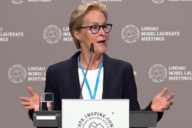You have /5 articles left.
Sign up for a free account or log in.
While skeptics want to see the evidence supporting a proposed merger of two South Australian universities, a proponent says the amalgamation would prepare the institutions for the unthinkable.
University of Adelaide vice chancellor Peter Høj said a post-COVID “reality check” explained why a merger with the neighboring University of South Australia (UniSA), which he led more than a decade ago, was in both institutions’ interests.
“We’re not a large state, and COVID was a big scare,” he said. “We’ve got to be realistic about a time where the demand for Australian education is not as pronounced as it is now.”
Høj said that if international students stopped coming to South Australia, neither university could sustain comprehensive activities, given their reliance on overseas tuition fees. Based on current projections, the combined entity would be Australia’s biggest enroller of domestic students.
“We would always be a viable university with an ability to cover the range of disciplines that any state would need,” he said. “There is going to be disruption coming our way, and universities know they have to change. We’re [creating] a platform where things have to change.”
Change would insulate both institutions against the currents threatening universities all over the world: scarce funds, demographic dips, competition from other models as well as other countries, the competing demands of work and mounting skepticism—from students, parents and employers—about the value of higher education.
Amid all this, the two universities can ill afford to “burn so much energy” by competing for primacy “in a relatively small state,” Høj said. “We will all be batting for the same brand.”
UniSA vice chancellor David Lloyd said the elements of the merger proposal were things the two universities would “do of our own volition” anyway. He said the combined institution would be different “in almost every conceivable way,” with a reconstructed curriculum “based around a digital platform.”
The constituent universities would “double down” on research concentrations in “the things we want to be known for over time,” he said, while delivering “equity and excellence in equal measure.”
This is something the Australian sector has struggled to achieve, with the top-ranked research institutions often placed near the bottom of the pack on measures of student satisfaction and diversity of admissions.
Høj predicted that the proposed institution would be ranked sixth in Australia on research, second on equitable access and within the top 10 on student experience. In the global rankings, it would be inside the top 100 within three to five years. “If we do the right thing … we [may] be inside the top 100 from day one.”
The merger’s many opponents want to see the modeling underpinning such claims. The universities have released an excerpt from a transition plan to bring the two institutions together, but not the feasibility-assessment documents that convinced their governing councils to support the union.
Critics say any possibility of transparency evaporated when Premier Peter Malinauskas reneged on an election commitment to establish a “commission” to explore university mergers, after the two institutions committed to a “serious” examination of the idea.
Opponents say the merger would be costly, and the 445 million Australian dollars ($300 million) committed to the project by the state government would be better spent funding the universities’ individual aspirations. They point to the stellar rankings achieved by relatively small institutions such as Harvard University and the University of Oxford, while some huge Australian campuses languish in the rankings.
Critics also cite merger impacts on institutional identity and alumni relations and say the universities’ promise to shun compulsory retrenchments for at least 18 months postmerger—watering down an earlier promise not to reduce net job numbers—neutralizes likely benefits from administrative efficiencies of scale.
Similar arguments are playing out in Western Australia, another sparsely populated state that has small universities by Australian standards and has struggled to increase domestic or international enrollments.
A state government–commissioned review of the four public universities is examining “structural change options” ranging from informal collaborations to mergers with each other, vocational colleges or even interstate institutions.
The state’s oldest and highest-ranked university says it is “open to any structural change” but appears lukewarm about amalgamations. “It is important to distinguish rank change created by a merger from that due to true improvement in the research underpinning the ranking,” the University of Western Australia notes in a submission to the review.
It says “competitive advantage in research capacity” could equally be achieved through joint research ventures or federation. A merger aimed at increasing research funding would need to foster “synergies and efficiencies without losing top researchers or creating reputational damage.”
The other three WA universities are firmly opposed to mergers. “We can see no advantage—and indeed many risks—in structural change,” says Curtin University’s submission.
“Big does not mean better,” says Edith Cowan University’s offering. “Any structural change resulting in fewer universities would mean less choice and more restricted access to higher education.”
Murdoch University says there is no “compelling evidence” that any structural change would deliver improved performance or sustainability. “There is also no evidence to suggest that WA public universities are not sustainable,” it adds.




